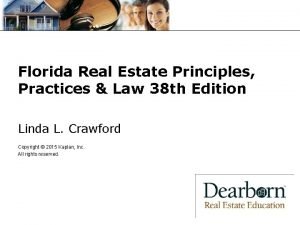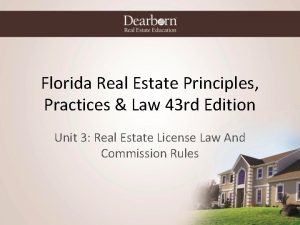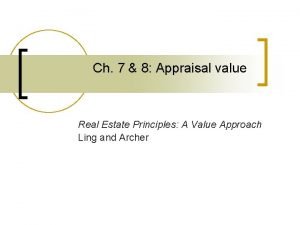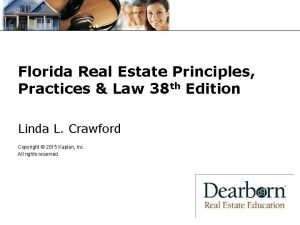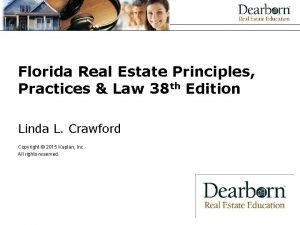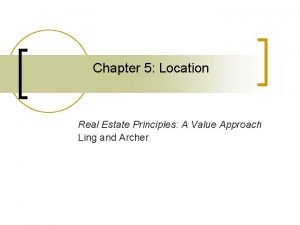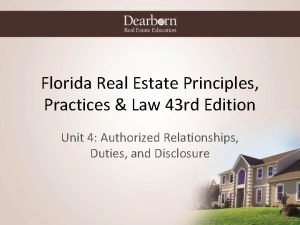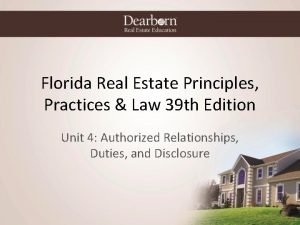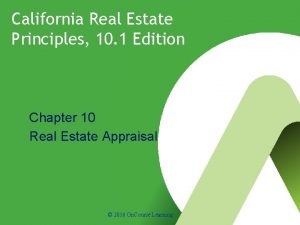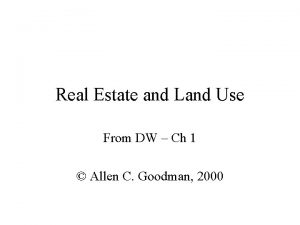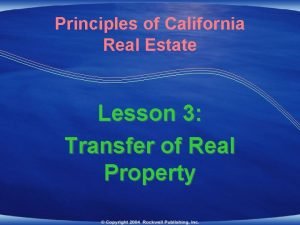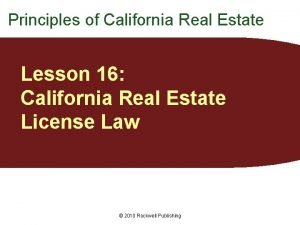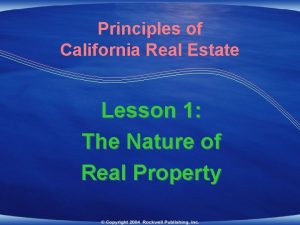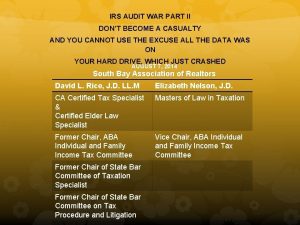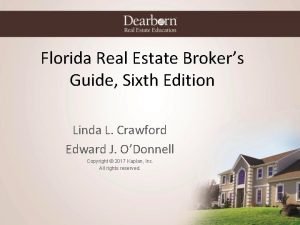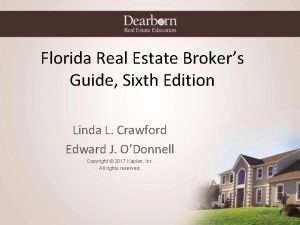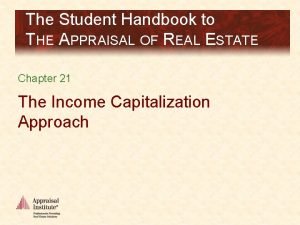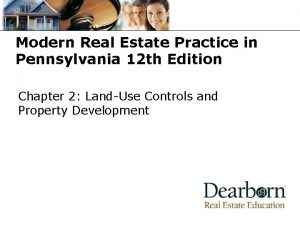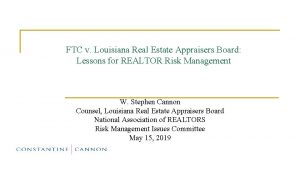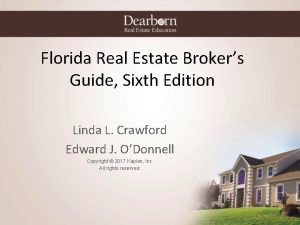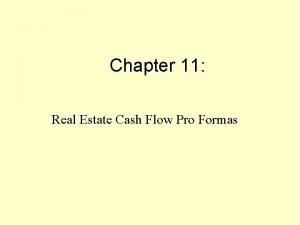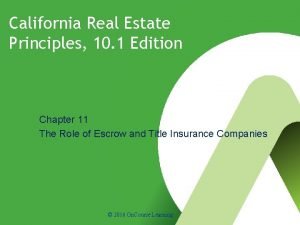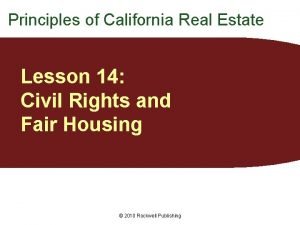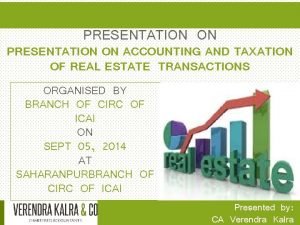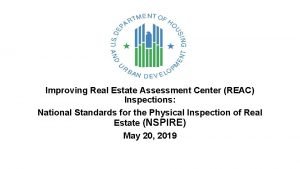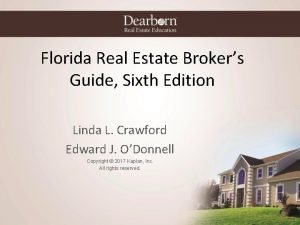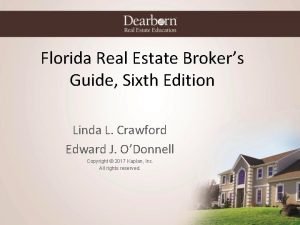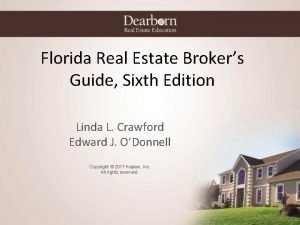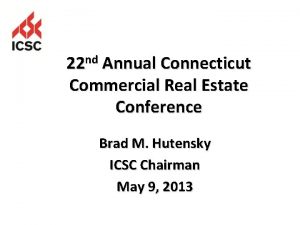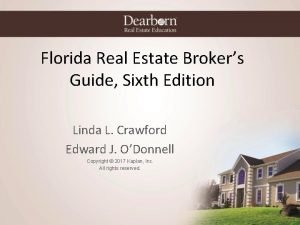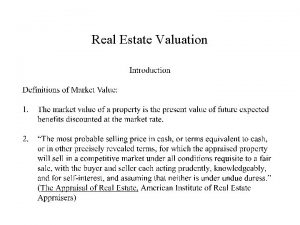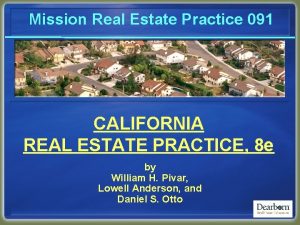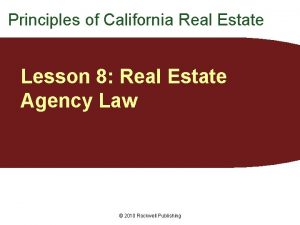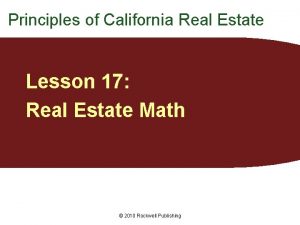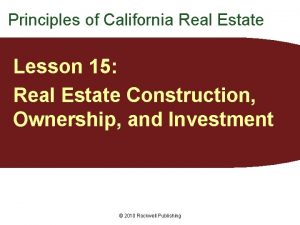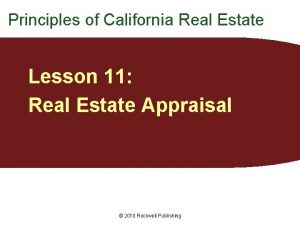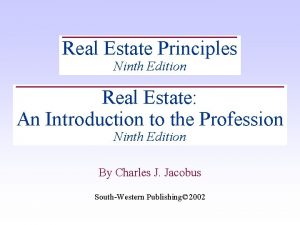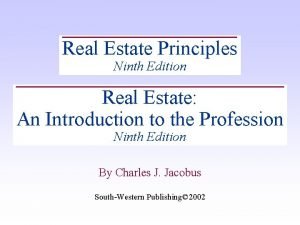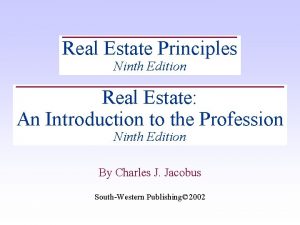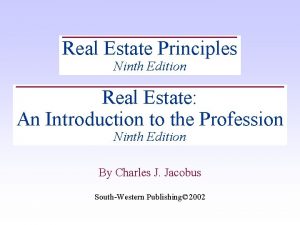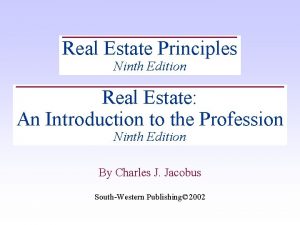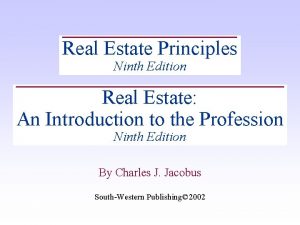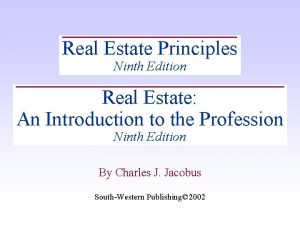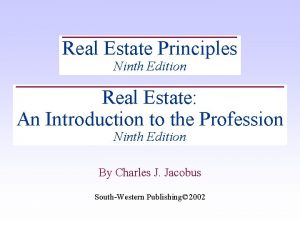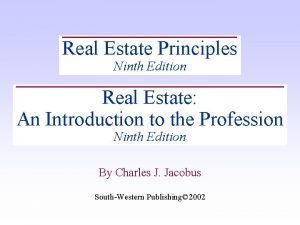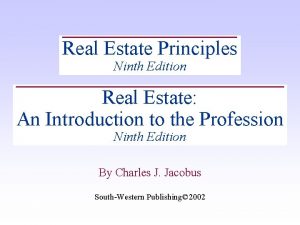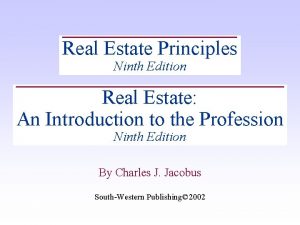Principles of California Real Estate Lesson 9 Principles





























































































- Slides: 93

Principles of California Real Estate Lesson 9: Principles of Real Estate Financing © 2010 Rockwell Publishing

Economics of Real Estate Finance Real estate cycles In real estate, there may be periodic shifts in market activity levels. Buyer’s market: Few people buying homes, and homes take longer to sell. Seller’s market: Many people buying, and homes sell quickly. © 2010 Rockwell Publishing

Economics of Real Estate Finance Real estate cycles follow law of supply and demand: l Housing prices go up when demand is high and supply low. l Prices go down when supply is high and demand low. © 2010 Rockwell Publishing

Economics of Real Estate Finance Interest rates and federal policy Interest rates represent price of mortgage funds; fluctuate in response to supply and demand. l When mortgage funds plentiful, interest rates are low. l When funds are scarce, interest rates are high—called a tight money market. © 2010 Rockwell Publishing

Interest Rates and Federal Policy Fiscal policy: Activities federal government pursues through spending, taxation and management of national debt. l For deficits, U. S. Treasury borrows money by selling interest-bearing securities to investors (T-Bills, T-Bonds). l Government borrowing leaves less money for private sector, driving interest rates up. © 2010 Rockwell Publishing

Interest Rates and Federal Policy Monetary policy: Federal government’s control of money supply and interest rates. l Monetary policy determined by Federal Reserve (the “Fed”). Economy tied to money supply & demand. l Low interest rates, economic activity increases. l If funds scarce, slowdown will result. © 2010 Rockwell Publishing

Interest Rates and Federal Policy Monetary policy Federal Reserve sets monetary policy using these adjustment tools: l key interest rates l reserve requirements l open market operations © 2010 Rockwell Publishing

Interest Rates and Federal Policy Monetary policy Key interest rates: When the Fed raises or lowers interest rates member banks pay the Fed, banks adjust interest rates for their customers, too. l Lower interest rates can stimulate economy. © 2010 Rockwell Publishing

Interest Rates and Federal Policy Monetary policy Reserve requirements: Amount the Fed requires banks to keep on deposit to meet requests for withdrawals. l If the Fed lowers reserve requirement, more money becomes available for loans and interest rates go down (and vice versa). © 2010 Rockwell Publishing

Interest Rates and Federal Policy Monetary policy Open market operations: The Fed’s buying and selling of government securities (such as Treasury notes). l When Fed purchases government securities, more private money becomes available and interest rates go down (and vice versa). © 2010 Rockwell Publishing

Summary Economics of Real Estate Finance • • Real estate cycles Supply and demand Fiscal policy Monetary policy Key interest rates Reserve requirements Open market operations © 2010 Rockwell Publishing

Real Estate Finance Markets Mortgage loans bought and sold like other investments, such as stocks and bonds. l Loan value depends on rate of return and risk of default. l “Seasoned loan” (one with history of timely payments) is more valuable. © 2010 Rockwell Publishing

Real Estate Finance Markets Primary market: Market in which mortgage lenders make loans directly to borrowers. Although primary market has become more regional or even national, local conditions still have big impact on funding lenders have available for loans. © 2010 Rockwell Publishing

Real Estate Finance Markets Secondary market: National market in which private investors and government agencies buy and sell mortgages. l Lets local lenders sell loans to national investors; moderates local cycles. l Secondary market transactions are between mortgagees (lenders/investors). © 2010 Rockwell Publishing

Real Estate Finance Markets Secondary market investors generally buy loans at discount (less than face value). l But discounted loans can be foreclosed for full face amount if borrower defaults. © 2010 Rockwell Publishing

Real Estate Finance Markets Secondary market agencies The federal government established secondary market agencies to help secondary market operate more smoothly: l Fannie Mae l Freddie Mac l Ginnie Mae © 2010 Rockwell Publishing

Real Estate Finance Markets Secondary market agencies Agencies buy large numbers of home loans and then sell securities to investors using purchased loans as collateral. l These are mortgage-backed securities. © 2010 Rockwell Publishing

Real Estate Finance Markets Secondary markets agencies Underwriting standards: To help lessen risk of loan defaults, federal agencies have established standard criteria for evaluating loan applicants. l If primary market lenders want to sell loans in secondary market, they need to conform to these standards. © 2010 Rockwell Publishing

Real Estate Finance Markets Secondary market agencies Federal National Mortgage Association (FNMA) or “Fannie Mae”: l Established to provide secondary market for FHA loans. (Now handles all loan types. ) l Government-sponsored enterprise (GSE). © 2010 Rockwell Publishing

Real Estate Finance Markets Secondary market agencies Federal Home Loan Mortgage Corporation (FHLMC) or “Freddie Mac”: l Established to provide secondary market for savings and loans, but now handles all loan types. l Like Fannie Mae, a governmentsponsored enterprise. © 2010 Rockwell Publishing

Real Estate Finance Markets Secondary market agencies Government National Mortgage Association (GNMA) or “Ginnie Mae”: l Government agency within HUD. l Buys and securitizes FHA and VA loans. © 2010 Rockwell Publishing

Real Estate Finance Markets Secondary market agencies In 2008, federal government placed Fannie Mae and Freddie Mac into conservatorship: essentially a government takeover of both agencies. l Result of recent recession. l New government regulator created for the two agencies: Federal Housing Finance Agency (FHFA). © 2010 Rockwell Publishing

Summary Real Estate Finance Markets • • • Primary market Secondary market Loan discounting Underwriting standards Secondary market agencies GSEs © 2010 Rockwell Publishing

Real Estate Finance Documents Most real estate transactions include: l promissory note l security instrument (mortgage or deed of trust) © 2010 Rockwell Publishing

Real Estate Finance Documents Promissory note: Written promise to repay debt, plus specified amount of interest. l Borrower = Maker l Lender = Payee © 2010 Rockwell Publishing

Real Estate Finance Documents Promissory notes Basic provisions: l loan balance (principal amount) l interest rate (fixed or variable) l payment amount and schedule l names of borrower and lender © 2010 Rockwell Publishing

Real Estate Finance Documents Promissory notes State usury laws may prohibit interest rate in note from exceeding specified amount. l In CA, however, most loans secured by real property are exempt from usury law. © 2010 Rockwell Publishing

Real Estate Finance Documents Promissory notes If each borrower is individually liable for entire loan amount, note will state that borrowers are jointly and severally liable for debt. © 2010 Rockwell Publishing

Real Estate Finance Documents Promissory notes Because note does not concern property, it need not include a legal description and is usually not recorded. © 2010 Rockwell Publishing

Types of Promissory Notes Straight note: Promissory note used for term loan or interest-only loan. l Payments made during loan term cover interest only (no principal). l At end of term, borrower must pay entire principal with balloon payment. © 2010 Rockwell Publishing

Types of Promissory Notes Installment note: Promissory note used for amortized loan, with part of each payment going to interest and principal. l Each payment reduces principal balance, until loan paid off. l Borrower pays less interest with installment note (vs. straight note). © 2010 Rockwell Publishing

Promissory Notes Simple interest Interest paid on real estate loan is always simple interest (not compound interest). l Computed annually on (remaining) principal balance only. © 2010 Rockwell Publishing

Promissory Notes Negotiable instruments Most promissory notes used in real estate are negotiable instruments. l Can be assigned to others by endorsement (signing over to another). l If endorsed “without recourse, ” endorsement is made without any assurances or warranty. © 2010 Rockwell Publishing

Promissory Notes Holder in due course: Third party who purchases negotiable instrument in good faith, unaware of any problems. l Entitled to payment even if there were problems with original transaction between payee and maker. © 2010 Rockwell Publishing

Real Estate Finance Documents Security instrument: Contract that makes borrower’s property collateral for loan. l If borrower doesn’t repay loan, lender can foreclose. l Forced sale of property. l Lender collects debt from proceeds. © 2010 Rockwell Publishing

Security Instruments Create lien Security instrument secures loan by creating lien on property. l Borrower gives property as collateral, but doesn’t give up possession. © 2010 Rockwell Publishing

Security Instruments Securing personal property Buyer of property may keep possession of property while repaying loan by using a security agreement. l In contrast, transferring personal property to lender pending repayment of loan is called a pledge (like pawnshop). © 2010 Rockwell Publishing

Security Instruments Recording Security instrument need not be recorded to be legal, but it should be, to give constructive notice of lender’s interest. l Real estate licensee who acts as mortgage loan broker is responsible for recording security instrument before funds disbursed (or within 10 days). © 2010 Rockwell Publishing

Security Instruments Classification as personal property While real estate notes, mortgages, and trust deeds are connected to real property, they are classified as personal property for owners. l Promissory note may be pledged as security for another loan. © 2010 Rockwell Publishing

Security Instruments Offset statement If loan is sold or assigned, investor may request an offset statement from borrower to: l confirm status of loan l describe any claims that could affect investor’s interests Same statement from lender is called a beneficiary’s statement. © 2010 Rockwell Publishing

Security Instruments Lender’s permission Borrower must get lender’s permission before making any changes that affect property’s value or lien priority. l Lender’s lien also includes any afteracquired title borrower gains in property (such as an easement). © 2010 Rockwell Publishing

Security Instruments Mortgages vs. deeds of trust Two types of security instruments: l mortgages l deeds of trust Main difference: foreclosure is easier with deed of trust. © 2010 Rockwell Publishing

Security Instruments Mortgages vs. deeds of trust Two parties to a mortgage: l mortgagor (borrower) l mortgagee (lender) © 2010 Rockwell Publishing

Security Instruments Mortgages vs. deeds of trust Three parties to a deed of trust: l trustor or grantor (borrower) l beneficiary (lender) l trustee (neutral third party who handles foreclosure, if necessary) © 2010 Rockwell Publishing

Security Instruments Mortgages vs. deeds of trust In California (and other states), lenders usually prefer deeds of trust because foreclosure is easier and faster. l Trustee holds deed “in trust” until loan has been repaid. l Trustee has power of sale in event of default (can sell without going to court). © 2010 Rockwell Publishing

Summary Real Estate Finance Documents • • • Promissory note Straight note Installment note Security instrument Mortgage Deed of trust © 2010 Rockwell Publishing

Finance Document Provisions Real estate documents contain numerous provisions: some mandatory, others optional. l Certain provisions are unique to security instruments, others also appear in promissory notes. © 2010 Rockwell Publishing

Finance Document Provisions Property description Security instrument must adequately describe the real property serving as collateral. © 2010 Rockwell Publishing

Finance Document Provisions Mortgaging or granting clause Security instrument must state that property is pledged as security for loan. l Mortgaging clause in a mortgage. l Granting clause in a deed of trust. © 2010 Rockwell Publishing

Finance Document Provisions Acceleration clause: Gives lender right to demand immediate payment of loan balance if borrower defaults; also known as “calling the note. ” l If borrower doesn’t meet the demand, lender can foreclose. l Can appear in promissory note and security instrument © 2010 Rockwell Publishing

Finance Document Provisions Alienation clause: Lets lender accelerate loan (demand immediate payment of loan balance) if borrower sells property or transfers it to someone else. l Also called a due-on-sale clause. l Lender may agree to assumption by creditworthy purchaser, but will likely charge a fee and raise the interest rate. © 2010 Rockwell Publishing

Finance Document Provisions Alienation clause does not prohibit sale of property, but borrower must be able to pay off loan if property sold without lender approval. © 2010 Rockwell Publishing

Finance Document Provisions Alienation clause If loan isn’t paid off when property sold or transferred, new purchaser can: l assume seller’s mortgage or deed of trust, or l take title subject to mortgage or deed of trust. © 2010 Rockwell Publishing

Finance Document Provisions Assumption In assumption: l new buyer assumes primary liability for repaying lender l original borrower remains secondarily liable, unless released by lender © 2010 Rockwell Publishing

Finance Document Provisions Taking title subject to existing lien If new buyer takes title subject to existing mortgage (instead of assuming it): l original borrower remains primarily liable for repayment l new buyer not personally liable for loan Lender can still foreclose if original borrower defaults. © 2010 Rockwell Publishing

Finance Document Provisions Late payment penalty Late payment charges allowed only if clearly defined in finance documents. l In CA, payment isn’t late until at least 10 days after due date, and l penalties can’t exceed (the greater of) 6% of principal and interest due or $5. l Federal law: limit of 4%, grace period of 15 days © 2010 Rockwell Publishing

Finance Document Provisions Lock-in clause: Prohibits borrower from paying loan off early. ● In CA, loans on residential property with four units or less cannot contain lock-in clauses. © 2010 Rockwell Publishing

Finance Document Provisions Prepayment penalty: Allows lender to charge borrower penalty if more than set amount of principal is paid back before due. l With owner-occupied residences, prepayment penalty only allowed during first 5 years of loan term under state law, or first 3 years under federal law. l If current interest rates high, lender more likely to waive prepayment penalties. © 2010 Rockwell Publishing

Finance Document Provisions Open mortgage: Loan without a prepayment penalty provision. © 2010 Rockwell Publishing

Finance Document Provisions Subordination clause: Makes it possible for security instrument recorded later to have higher lien priority (than earlier recorded instrument). © 2010 Rockwell Publishing

Finance Document Provisions Subordination clause Often found in security instrument for loan purchasing vacant land. l Buyer plans to obtain construction loan. l Later lender will want first lien position for construction loan (higher risk). © 2010 Rockwell Publishing

Finance Document Provisions Defeasance clause: Lender agrees to cancel security instrument when debt is paid. l If security instrument was deed of trust, lien removed through deed of reconveyance. l When mortgage paid, certificate of discharge removes lien. © 2010 Rockwell Publishing

Finance Document Provisions Defeasance clause For deed of trust, beneficiary must submit request for reconveyance to trustee within 30 days after loan paid. Trustee has 21 days to execute deed of reconveyance. l Need not be recorded, but should be to protect trustor. © 2010 Rockwell Publishing

Summary Finance Document Provisions • • Acceleration clause Alienation clause Late payment penalty Lock-in clause Prepayment penalty Subordination clause Defeasance clause © 2010 Rockwell Publishing

Foreclosure is lender’s remedy when borrower defaults. l Can be done judicially (in court) or nonjudicially. Actions constituting default include: l failure to repay loan l using property for illegal purpose l failing to insure or maintain property © 2010 Rockwell Publishing

Judicial Foreclosure If borrower defaults, mortgagee files lawsuit (foreclosure action) in county where property located. l Judge issues decree of foreclosure. l Property sold at public auction (“sheriff’s sale”). © 2010 Rockwell Publishing

Judicial Foreclosure Reinstatement While foreclosure action pending, borrower has right to reinstatement. l Reinstatement period lasts until foreclosure decree is issued. To reinstate loan, borrower must pay: l past due amount l any foreclosure costs incurred © 2010 Rockwell Publishing

Judicial Foreclosure Redemption Even after sheriff’s sale of property, borrower has statutory right of redemption. Borrower may redeem property by paying off: l entire debt l interest l all foreclosure expenses © 2010 Rockwell Publishing

Judicial Foreclosure Redemption In California, redemption period lasts: l three months if sale proceeds were enough to cover debt, or l one year if sale proceeds were not enough to cover the debt No redemption period if lender waives deficiency judgment or not allowed to seek deficiency judgment. © 2010 Rockwell Publishing

Judicial Foreclosure Redemption During redemption period, borrower may retain possession of property but must pay rent. Successful purchaser at sheriff’s sale receives sheriff’s deed after redemption period, which transfers title and possession. © 2010 Rockwell Publishing

Judicial Foreclosure Surplus or deficiency After all liens paid off, borrower receives any surplus from foreclosure sale. If proceeds don’t cover loan amount, lender may be entitled to deficiency judgment; l Not allowed with most residential loans. © 2010 Rockwell Publishing

Nonjudicial Foreclosure Power of sale clause: Provision in deed of trust that authorizes trustee to sell property if borrower defaults (without going to court). l Most mortgages have no equivalent provision. © 2010 Rockwell Publishing

Nonjudicial Foreclosure Nonjudicial foreclosure must be conducted in accordance with statutory procedures. l Trustee sends notice of default to borrower and other lienholders. l Three months later, trustee posts and advertises notice of sale. l Trustee holds auction (trustee’s sale) at least 3 months and 20 days after notice of default. l Winning bidder receives trustee’s deed. © 2010 Rockwell Publishing

Nonjudicial Foreclosure Reinstatement and redemption Borrower may reinstate loan (and redeem property) by paying past due amount plus costs, up to 5 days before trustee’s sale. l Reinstatement period lasts at least 3 months and 15 days. No post-sale redemption option (unlike judicial foreclosures). © 2010 Rockwell Publishing

Nonjudicial Foreclosure Deficiency judgments not permitted in nonjudicial foreclosures. l Lenders may pursue judicial foreclosure to seek deficiency judgment. Notice to other lienholders important because junior lienholders’ claims terminated by trustee’s sale. © 2010 Rockwell Publishing

Alternatives to Foreclosure If borrower can’t reinstate loan, lender may accept deed in lieu of foreclosure. l Transfers title from borrower to lender. l Lender takes title subject to liens. Other alternatives to foreclosure include short sales and loan modification. © 2010 Rockwell Publishing

Alternatives to Foreclosure Recent law State law imposes special requirements on lenders that are foreclosing on residential loans made during boom years (2003 -2007), including longer notice periods. Generally, persons providing consultancy to homeowners facing foreclosure must have a written agreement with borrower. Various other rules apply. © 2010 Rockwell Publishing

Foreclosure vs. Bankruptcy and foreclosure are separate legal procedures. l If borrower facing foreclosure files for bankruptcy, foreclosure proceedings are temporarily put on hold. © 2010 Rockwell Publishing

Summary Foreclosure • • Judicial foreclosure Nonjudicial foreclosure Reinstatement Redemption Deficiency judgment Deed in lieu of foreclosure Bankruptcy © 2010 Rockwell Publishing

Types of Mortgage Loans Even though various loans secured by real property are often called “mortgage loans, ” in California security instrument for these loans will usually be deed of trust (not mortgage). © 2010 Rockwell Publishing

Types of Mortgage Loans First mortgage: Loan with first lien priority. l Loans with lower priority are known as second mortgages, third mortgages, and so on. l Generally, called junior mortgages. © 2010 Rockwell Publishing

Types of Mortgage Loans Purchase money mortgage: Any mortgage loan used to buy property that serves as security for loan. l May also refer to seller financing, where seller extends credit instead of requiring full payment at closing. (Also called soft money mortgage. ) © 2010 Rockwell Publishing

Types of Mortgage Loans Hard money mortgage: When borrower gives lender mortgage and receives cash in exchange. © 2010 Rockwell Publishing

Types of Mortgage Loans Package mortgage: Mortgage used to finance real property and personal property. l Example: office or farm equipment included in sale of real property. © 2010 Rockwell Publishing

Types of Mortgage Loans Construction mortgage: Temporary (or interim) loan used to finance construction of land improvements. l Loan funds are usually disbursed to borrower as construction proceeds using fixed disbursement plan. © 2010 Rockwell Publishing

Types of Mortgage Loans Construction mortgage When construction complete, interim loan replaced by permanent financing (called a take -out loan). Lender’s promise to give a (future) take-out loan is called a standby loan commitment. © 2010 Rockwell Publishing

Types of Mortgage Loans Blanket mortgage: When several properties are used to secure one loan. l Common in subdivision development. Partial release clause: Requires lender to release some of properties from blanket lien when specified portions have been paid off. © 2010 Rockwell Publishing

Types of Mortgage Loans Open-end mortgage: Mortgage that allows borrower who has paid back part of loan to re-borrow funds, up to a limit. l Often used by builders and farmers. © 2010 Rockwell Publishing

Types of Mortgage Loans Subprime mortgage: Loan made to borrower who may not qualify for ordinary mortgage loan, often because of poor credit history, high debt-to-income ratio, or lack of documentation. l Lender usually charges higher interest rates and fees to offset risk. © 2010 Rockwell Publishing

Types of Mortgage Loans Home equity loan: Borrower uses equity in residence to get mortgage loan. l Money can be used for expenses unrelated to property—medical bills, college tuition, etc. Home equity line of credit (HELOC): Revolving line of credit, much like credit card, but debt secured by borrower’s home. © 2010 Rockwell Publishing

Types of Mortgage Loans Refinancing: Borrower obtains new mortgage loan to replace existing one, using funds from refinance to pay off old loan. Often used when: l interest rates are low l date of balloon payment approaching © 2010 Rockwell Publishing

Land Contracts In seller-financed transaction, seller may use land contract to extend credit, rather than mortgage or deed of trust. l Land contract serves as both promissory note and security instrument. l Also called contract for deed or installment sales contract. © 2010 Rockwell Publishing

Summary Mortgage Loans and Land Contracts • • Purchase money mortgage Package mortgage Construction mortgage Blanket mortgage Open-end mortgage Home equity loan Refinancing Land contract © 2010 Rockwell Publishing
 Southpoint village apartments fishers indiana
Southpoint village apartments fishers indiana Florida real estate principles practices & law
Florida real estate principles practices & law Involuntary inactive real estate license florida
Involuntary inactive real estate license florida Income approach appraisal
Income approach appraisal Florida real estate principles practices
Florida real estate principles practices Ostensible partnership real estate
Ostensible partnership real estate Rent real estate principles a value approach
Rent real estate principles a value approach Florida real estate principles practices & law 43rd edition
Florida real estate principles practices & law 43rd edition Florida real estate principles practices
Florida real estate principles practices Rent real estate principles a value approach
Rent real estate principles a value approach Realtor elevator pitch example
Realtor elevator pitch example Kwueval
Kwueval Real estate stakeholders
Real estate stakeholders Greece property market
Greece property market Sandy miller real estate
Sandy miller real estate Riparian rights vs littoral rights
Riparian rights vs littoral rights What are the 4 types of real estate
What are the 4 types of real estate Financial investment analysis
Financial investment analysis Crm software for real estate law
Crm software for real estate law 4 quadrant model economics
4 quadrant model economics Involuntary alienation in real estate
Involuntary alienation in real estate Blind ad real estate
Blind ad real estate Emblements real estate
Emblements real estate Panama real estate law
Panama real estate law Encumbered real estate
Encumbered real estate Objectives of industrial estates
Objectives of industrial estates Irs audit real estate professional
Irs audit real estate professional Immobility real estate
Immobility real estate Florida real estate broker's guide 6th edition
Florida real estate broker's guide 6th edition Florida real estate broker's guide 6th edition
Florida real estate broker's guide 6th edition What is space market in real estate
What is space market in real estate Erp for real estate developers
Erp for real estate developers Arizona real estate law book
Arizona real estate law book Millionaire real estate investor worksheets
Millionaire real estate investor worksheets Real estate buyers packet
Real estate buyers packet Colliers turley martin tucker
Colliers turley martin tucker The student handbook to the appraisal of real estate
The student handbook to the appraisal of real estate Conclusion of real estate management system
Conclusion of real estate management system Urban economics and real estate markets
Urban economics and real estate markets Haji real estate
Haji real estate Modern real estate practice in pennsylvania
Modern real estate practice in pennsylvania Modern real estate practice in illinois
Modern real estate practice in illinois Real estate lecture
Real estate lecture Thanandpaul.com real estate
Thanandpaul.com real estate La real estate appraisers board
La real estate appraisers board Free real estate presentation templates
Free real estate presentation templates Florida real estate broker's guide
Florida real estate broker's guide Denver real estate investment associations
Denver real estate investment associations Real estate development proposal presentation
Real estate development proposal presentation Real estate investment pro forma
Real estate investment pro forma Easton v strassburger real estate
Easton v strassburger real estate Closing statements real estate
Closing statements real estate Bhubaneswar real estate market
Bhubaneswar real estate market Non performing notes investing
Non performing notes investing Hud reo
Hud reo Unlimited funding for real estate
Unlimited funding for real estate Seizen real estate
Seizen real estate Rre dnb
Rre dnb Rti meaning real estate
Rti meaning real estate Psak 44
Psak 44 Ebrd real estate
Ebrd real estate Unruh civil rights act real estate
Unruh civil rights act real estate Guidance note on accounting for real estate transactions
Guidance note on accounting for real estate transactions Moldova real estate market
Moldova real estate market Alpine commercial broker
Alpine commercial broker Dan duffy united real estate
Dan duffy united real estate Nspire reac
Nspire reac Hartel commercial real estate
Hartel commercial real estate Florida real estate broker's guide 6th edition
Florida real estate broker's guide 6th edition Florida real estate broker's guide 6th edition
Florida real estate broker's guide 6th edition Florida real estate broker's guide 6th edition
Florida real estate broker's guide 6th edition Florida real estate broker's guide
Florida real estate broker's guide Best entity for real estate
Best entity for real estate Touch base real estate
Touch base real estate Real estate case study examples
Real estate case study examples Sanderson commercial land for lease
Sanderson commercial land for lease Social media plan for real estate
Social media plan for real estate Asc 805
Asc 805 Cyber real estate
Cyber real estate Joseph steven valenzuela
Joseph steven valenzuela Global re real estate
Global re real estate The greatest real estate deal in history
The greatest real estate deal in history Schedule c for real estate agents
Schedule c for real estate agents Real estate risk management fee
Real estate risk management fee Estonian real estate market
Estonian real estate market Straight note real estate
Straight note real estate Ohio river real estate
Ohio river real estate Nobody sells more
Nobody sells more Retail real estate conference
Retail real estate conference Modern real estate practice in pennsylvania
Modern real estate practice in pennsylvania Real estate finance fundamentals
Real estate finance fundamentals Al aqqad real estate valuation
Al aqqad real estate valuation Real estate utilisation
Real estate utilisation Florida real estate broker's guide 6th edition
Florida real estate broker's guide 6th edition

